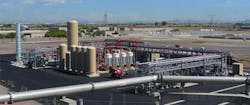Renewable Natural Gas as an Option for Microgrids
The city of Phoenix, Ariz. is taking raw biogas produced at its wastewater treatment plant and cleaning it before it is compressed and injected in natural gas pipelines. The ultimate commodity is known as renewable natural gas, produced from any organic material found in landfills, sewage treatment or bio-digesters — and an excellent substitute for fossil fuels in microgrids.
The city is converting an existing resource into energy that would otherwise get sent into the atmosphere and create greenhouse gas emissions. While such renewable natural gas is now mostly used in the transport sector, it can also be used to heat homes and businesses. Microgrids need to be able operate independently of the main grid — to island themselves — in the case of an outage and thus must be reliable and resilient.
New renewable natural gas facility in Phoenix. Courtesy of Ameresco
“If you want to island, you need some form of combustion process to sustain a lengthy outage,” says Michael Bakas, executive vice president of Ameresco, in an interview.
So far that’s meant using fossil fuels. “Solar and solar storage will not carry you through. You need a peaker plant or a cogeneration plant,” he says.
Renewable natural gas can fuel the peaker or cogeneration plants to create a greener microgrid.
Ameresco’s processing plant converts the raw biogas to renewable natural gas for the city of Phoneix. Its wastewater plant, now operational, is capable of processing 3,250 standard cubic feet per minute of raw digester gas produced at the wastewater treatment plant.
The facility is also providing tangible economic benefits to the surrounding areas, including reducing the equivalent of 44,600 metric tons of carbon dioxide (CO2) a year, Ameresco says. Instead of allowing the biogas to vent into the atmosphere, it is processed into a natural gas resource and injected into a pipeline. From there, it can be transported to most places in the United States.
So what’s the catch? Bakas says that it takes energy to convert biogas to renewable natural gas. Whether that process is more energy-intensive than the extraction process is up for debate. But the end product has substantial environmental benefits. At the same time, he adds that what comes out of the burner tip has same the level of energy content as does pure gas.
Join us in San Diego, Calif., May 14-16 at Microgrid 2019 where Ameresco’s Michael Bakas will be a featured speaker.
The conversion process has a cost associated with it, making renewable natural gas more expensive than natural gas. But Bakas points out that using cleaner energy provides not only an environmental plus but ultimately an economic one, as the cost of the technology falls.
Renewable natural gas is considered to be carbon-neutral because it comes from organic sources that had once absorbed CO2 during photosynthesis. Navigant Consulting says that replacing 16% of the traditional natural gas supply with renewable gas captured from sources like dairies, wastewater treatment plants and landfills would take a big chunk out of greenhouse gas emissions in California — the equivalent of converting all the of buildings there to electric energy by 2030.
Track news about the use of renewable natural gas in microgrids. Subscribe to the free Microgrid Knowledge newsletter.
About the Author

